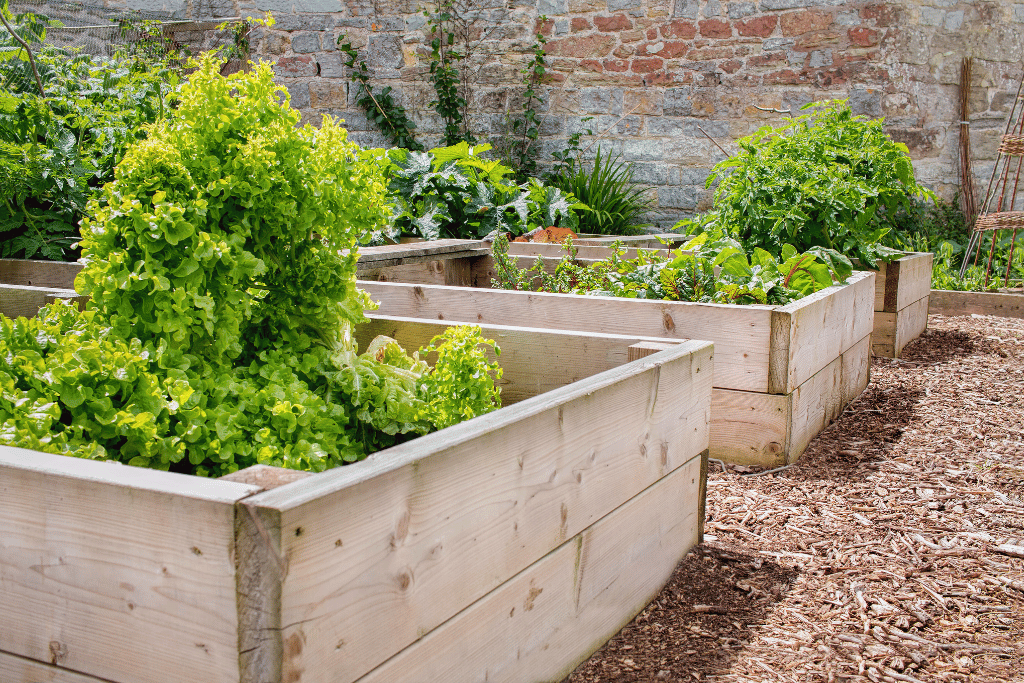
When it comes to gardening, I’m not one to shy away from a DIY project. A few years back, I decided to build a raised garden bed in my backyard. I was brimming with enthusiasm, ready to plant some beautiful flowers and veggies, and create a little green oasis right at home.
But, you know what they say, “The road to a lush garden is paved with good intentions.” Well, okay, maybe they don’t say exactly that, but they should! My first attempt at a raised garden bed didn’t quite turn out as planned. I went with any old wood I had lying around, thinking it would do the job just fine. Spoiler alert: it didn’t.
My garden bed was a soggy mess, overrun by hungry insects, and even the wood started showing signs of wear and tear in no time. I knew I had to figure out the best wood for raised garden beds if I wanted my green dreams to come true.
Factors to Consider When Choosing Wood For Raised Garden Bed
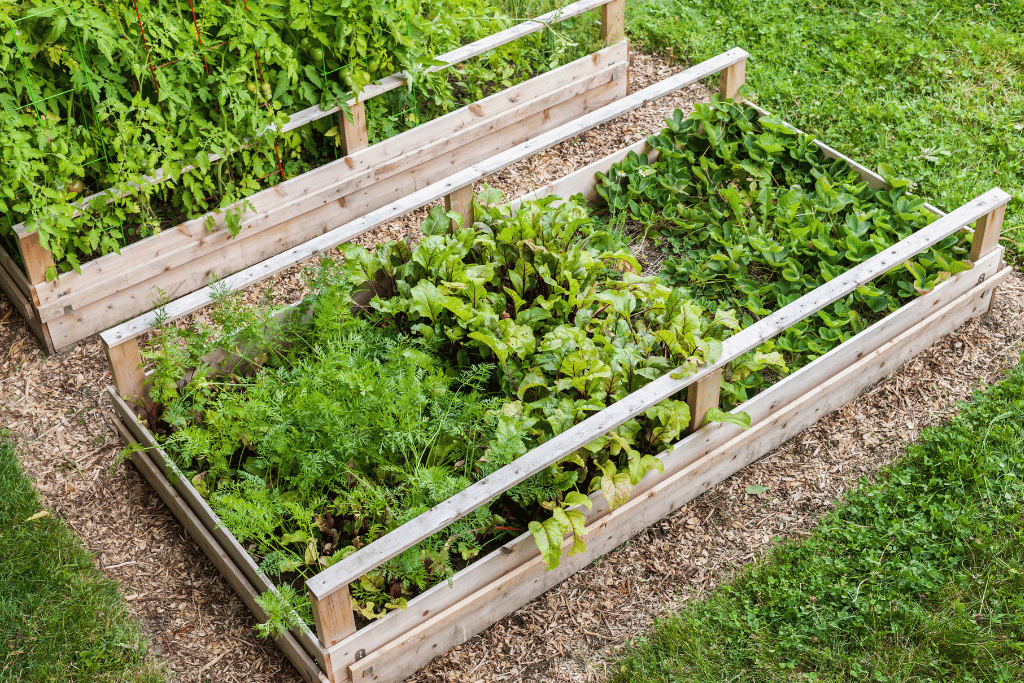
To avoid the mess I found myself in, you need to consider some key factors when choosing the right wood.
First, rot resistance – because soggy, rotting wood is no one’s idea of a great garden. I learned that some types of wood naturally resist rot, while others need a little extra help in the form of treatment.
Durability is another vital factor. You want your garden bed to last for years, right? So, think about the hardness and density of the wood, as well as its resistance to insects and decay. The last thing you want is to have to replace your garden bed after just one season.
Of course, cost plays a significant role too. Initial expenses and long-term cost-effectiveness should be on your radar. I’ll let you in on a little secret – sometimes spending a bit more upfront can save you a lot in the long run.
And we can’t ignore the environmental impact. You’d want your garden to be kind to the planet, wouldn’t you? Think about where the wood comes from and how it’s sourced. Chemical treatments used can also affect the environment, so it’s worth considering that too.
And lastly, maintenance – no one wants a high-maintenance garden bed. You’ll need to look after your wooden wonder, but some woods are a lot easier to care for than others.
Benefits of Using Wood for Raised Garden Beds
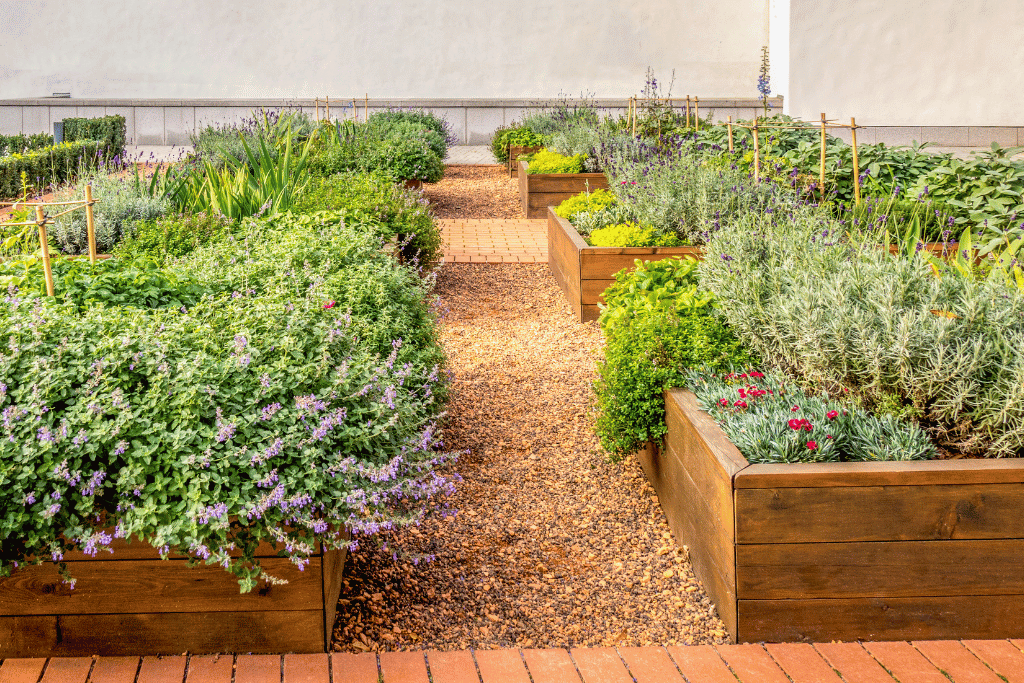
When it comes to raised garden beds, wood has some compelling advantages that make it a preferred choice for many gardeners.
1. Natural Aesthetics: Enhancing Garden Beauty
Wooden raised garden beds seamlessly blend with the natural environment, enhancing the overall aesthetics of your garden. The warm hues of cedar, the rich tones of redwood, and the classic appearance of pine provide a timeless and pleasing visual appeal. This natural beauty complements the greenery of your plants and adds an organic touch to your garden landscape.
2. Versatility: Tailored to Your Needs
One of the key benefits of wood is its versatility in design. Gardeners can create raised beds of various shapes, sizes, and heights to suit their specific gardening preferences. Whether you have limited space in an urban garden or a vast expanse in a rural setting, wood can be customized to fit your needs. This flexibility allows you to design garden beds that align with your garden layout and style.
3. Ease of Assembly: DIY-Friendly
Wooden raised beds are known for their user-friendliness. The construction of wood-based garden beds typically requires basic carpentry tools and skills, making them accessible to gardeners with various levels of experience. This ease of assembly is particularly advantageous for those who enjoy DIY projects, as it empowers them to construct their garden beds without the need for advanced carpentry knowledge.
4. Customization: Tailoring Garden Beds to Your Space
Customization is a significant advantage of using wood for raised garden beds. Gardeners can easily adjust the dimensions and features of wooden beds to precisely fit the available space and meet their specific gardening requirements. This adaptability extends to incorporating features like trellises, benches, or integrated irrigation systems, enabling gardeners to create garden beds that align with their unique preferences and needs.
5. Excellent Drainage: Healthy Soil Conditions
Proper drainage is vital for maintaining healthy soil conditions in a garden. Wooden raised beds offer good drainage as they allow excess water to escape, preventing waterlogged soil. Adequate drainage not only safeguards plant roots from rot but also promotes aeration, which is essential for healthy plant growth. This benefit is particularly valuable in regions with heavy rainfall or when dealing with moisture-sensitive plants.
6. Warmth to Soil: Extending the Growing Season
Wooden garden beds have the capacity to absorb and retain heat from the sun. This unique property warms the soil earlier in the spring and extends the growing season, providing an advantage to gardeners in colder climates or those eager to start planting earlier in the year. The additional warmth to the soil promotes faster germination and robust early-season growth.
7. Soil Protection: Preventing Contamination
Wooden garden bed walls serve as a protective barrier between your garden soil and the surrounding ground. This separation helps safeguard your garden from potential contaminants and invasive grasses. It maintains the integrity of your garden soil composition, ensuring that it remains free from harmful external influences.
8. Accessibility: Gardening for All Ages
Elevated garden beds, such as those made from wood, provide easy access to the garden for gardeners of all ages and abilities. These beds reduce the need for stooping, bending, or kneeling, making gardening more comfortable and accessible. This accessibility is especially valuable for individuals with mobility challenges or those seeking a more ergonomic gardening experience.
9. Pest Control: Natural Deterrents
Certain types of wood, like cedar and redwood, contain natural oils and compounds that deter pests. The aromatic qualities of these woods act as a natural pest control measure, reducing the need for chemical interventions. This benefit not only contributes to plant health but also aligns with environmentally friendly gardening practices.
10. Longevity: A Durable Garden Solution
When properly maintained, wooden garden beds can enjoy a long lifespan. Woods like cedar and redwood, which are naturally resistant to decay and insects, are known for their exceptional durability. This longevity transforms wood into a sustainable and cost-effective choice, as it reduces the need for frequent replacement or repairs.
11. Environmentally Friendly: Sustainable Sourcing and Disposal
Wooden garden beds can be environmentally friendly when sourced from sustainable forestry practices. The use of woods with certifications like the Forest Stewardship Council (FSC) ensures responsible harvesting. Additionally, wood is a biodegradable material, allowing for eco-friendly disposal when the time comes to replace or retire a garden bed.
12. Opportunity for Creative Finishes: Expressing Personal Style
Wooden garden beds offer the opportunity for creative finishes. Whether left natural, stained, painted, or adorned with unique designs, wood allows gardeners to express their personal style in the garden. This creative flexibility empowers individuals to make their garden beds a reflection of their preferences and personality.
13. Complements Other Garden Features: Coordinating With the Landscape
Wooden garden beds are versatile and can be coordinated with various garden features. Their neutral and organic appearance allows them to complement other elements in the garden, such as fencing, pathways, or outdoor structures. This ability to blend with the landscape enhances the overall cohesion of garden design.
7 Best Wood for Raised Garden Beds
Before you start digging in the dirt, there’s an important decision to make – what wood should you use? Choosing the best wood for raised garden beds is like picking the right ingredients for your favorite recipe; it can make or break the final result.
I’ve been down this gardening road myself, and let me tell you, I’ve learned a thing or two along the way.
1. Cedar
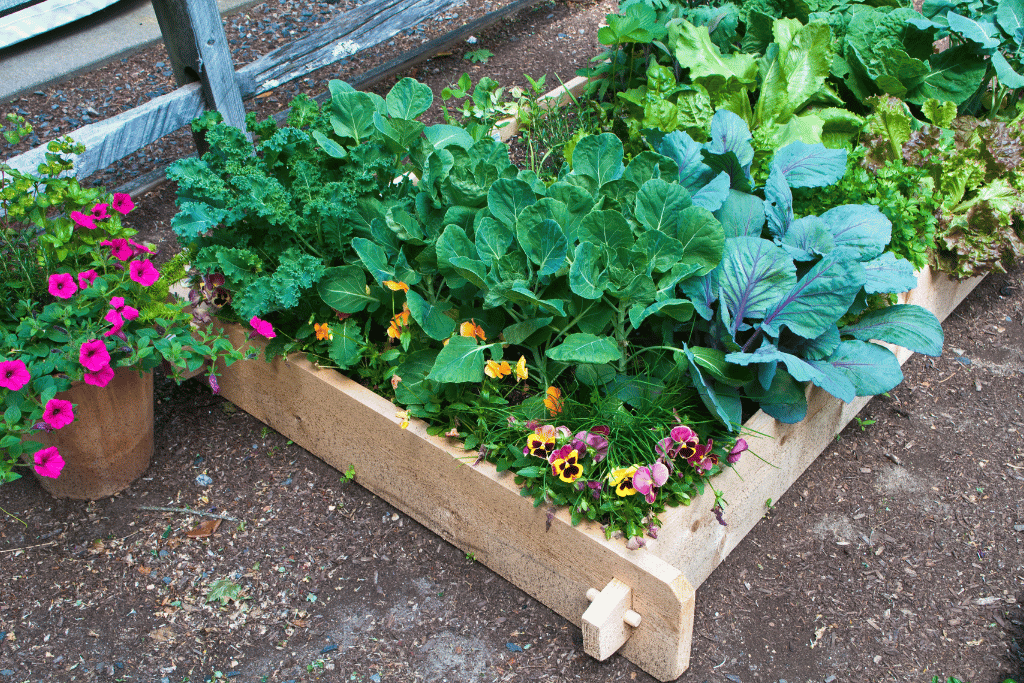
Characteristics: Let’s start with the classic choice: cedar. Cedar is like the A-lister of the wood world for garden beds, and it’s earned its star status. What makes cedar so special? Well, it’s naturally rot-resistant, which means you won’t have to worry about your garden bed slowly disintegrating over time. This wood is also lightweight and easy to work with, which is a huge plus if you’re a DIY enthusiast. And here’s a little bonus – it has that unmistakable cedar scent. It’s like aromatherapy for your garden!
Pros: Low maintenance, long-lasting, and it even repels certain insects.
Cons: On the downside, it can be a bit pricier than other options and might not be readily available everywhere.
Best Uses: For flower beds and gardeners looking for a low-maintenance, aesthetically pleasing solution, cedar is often the top choice and for many, it the best wood for raised garden beds.
2. Redwood
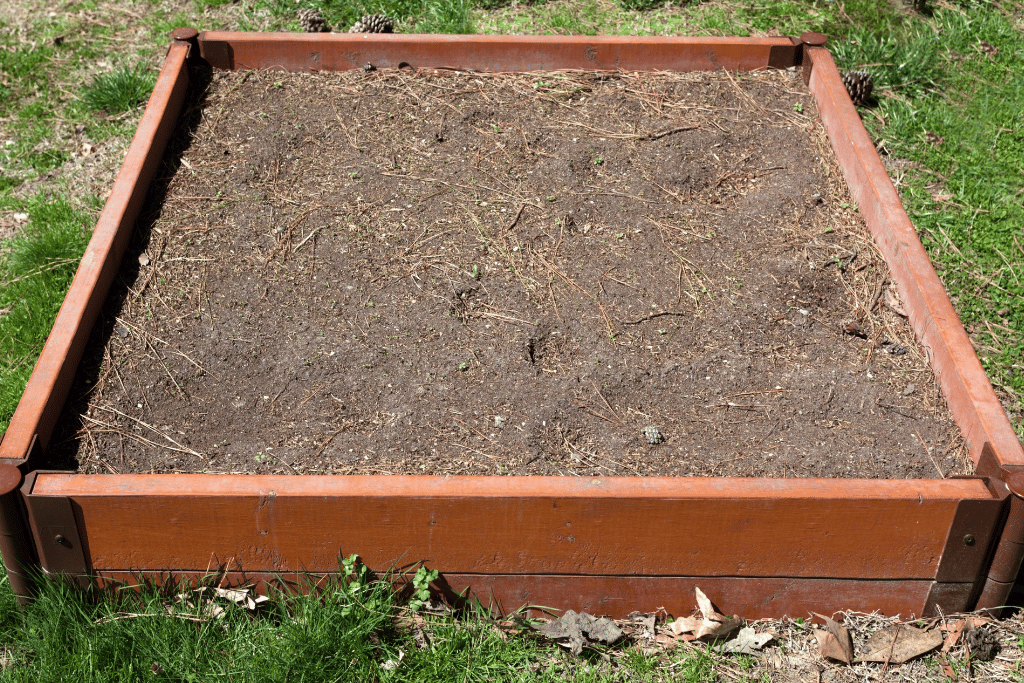
Characteristics: Now, let’s talk about the wood that’s basically the James Bond of the gardening world – redwood. It’s not just any wood; it’s naturally resistant to decay and insects, which means your garden bed will stand up to the elements and creepy-crawlies with style.
Redwood is also known for its stunning reddish-brown color and fine grain, making your garden bed not only durable but also drop-dead gorgeous.
Pros: High durability, beauty that’s easy on the eyes, long-lasting, and low maintenance.
Cons: But, and you knew there was a “but” coming, it’s not the most budget-friendly option, and its availability might be a tad limited in some regions.
Best Uses: If you’re looking to create a garden bed that’s both visually stunning and built to last, redwood is your wood of choice.
3. Pressure-Treated Wood
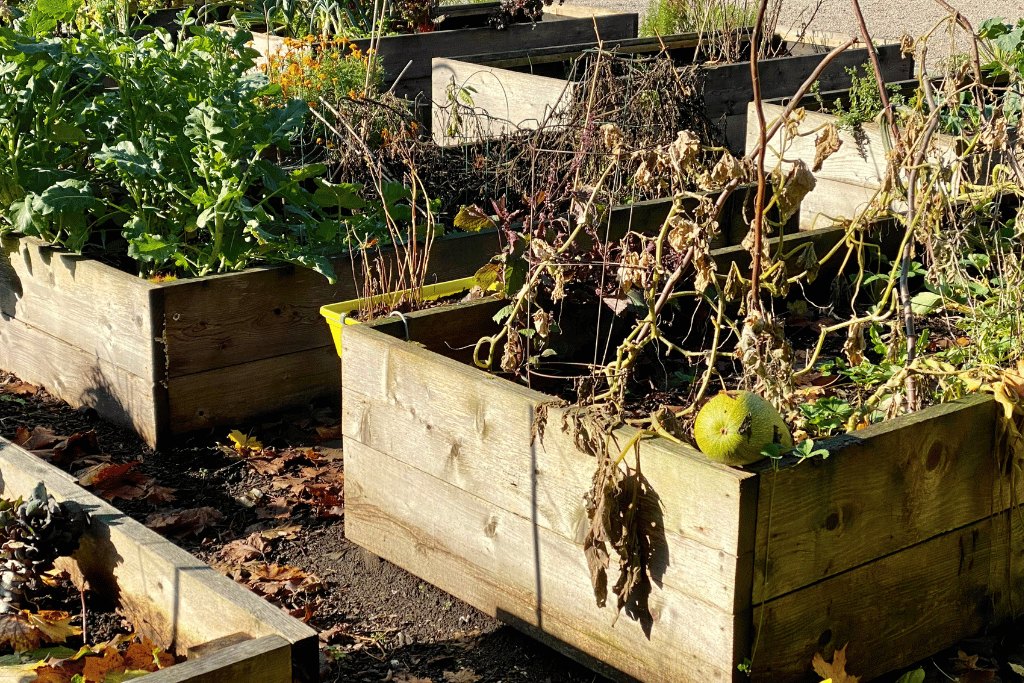
Characteristics: Now, let’s talk budget-friendly – pressure-treated wood. This wood is often pine or fir, and it gets a special treatment to resist decay and insects. It’s like your garden bed’s superhero suit, protecting it from the villains of the gardening world.
Pros: Well, it’s kinder to your wallet, suitable for various garden sizes, and can go the distance with proper care.
Cons: The chemical treatments might raise some environmental concerns, and you’ll need to roll up your sleeves for a bit more maintenance than some of the naturally resistant woods.
Best Uses: Pressure-treated wood is a practical choice for those gardeners who want to save some green while enjoying a reliable and robust garden bed. It’s especially ideal for vegetable and herb gardens, where you might be replanting frequently.
4. Composite Wood
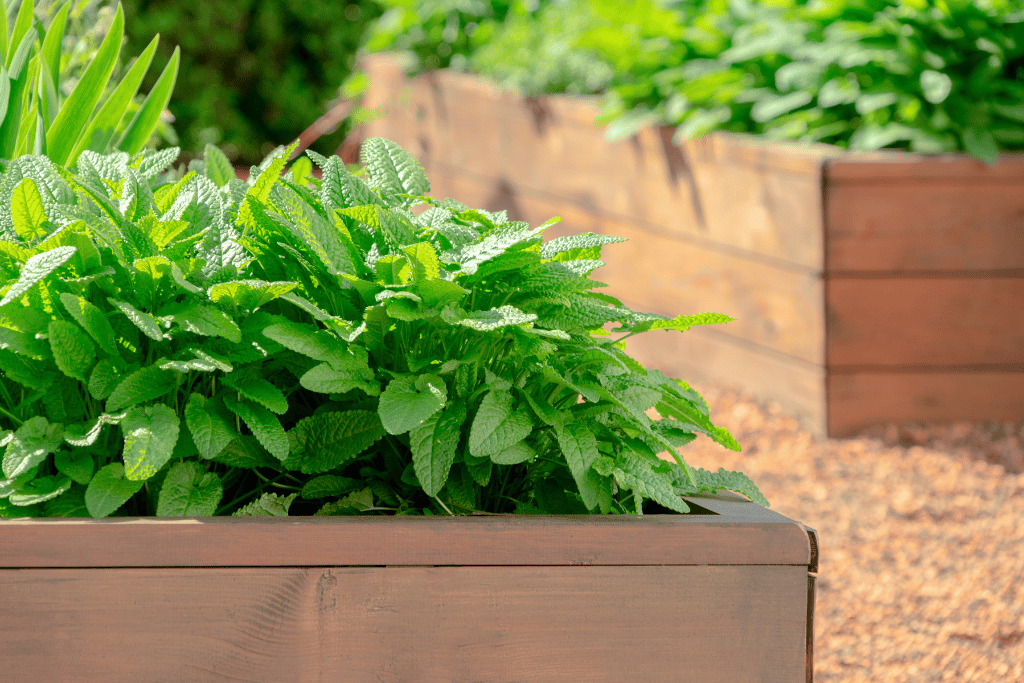
Characteristics: If you’re in the mood for the best of both worlds – the natural look of wood without the nagging maintenance – say hello to composite wood. This stuff is like the Swiss Army knife of garden bed materials. It’s a blend of wood fibers and plastic, which results in a garden bed that’s durable, resistant to rot and insects, and virtually maintenance-free. And hey, no more worrying about splinters or warping – this wood’s got your back.
Pros: Long-lasting, low maintenance, and resistant to splinters and warping.
Cons: Relatively higher initial cost, and it may not have the same natural wood aesthetics.
Best Uses: For gardeners who want a long-lasting, low-maintenance garden bed that still has that classic wood appearance.
5. Pine
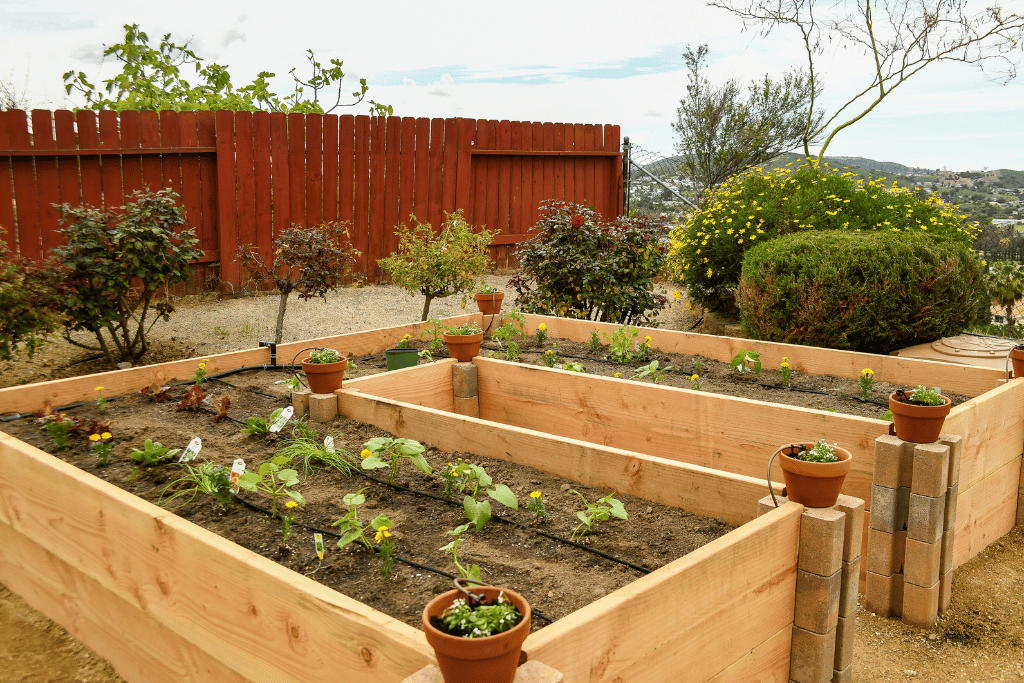
Characteristics: Got a tight budget? No problem – pine’s here to save the day. It might not come with the natural resistance to decay and insects that cedar or redwood offer, but with the right treatment and care, it can be a reliable choice for your raised garden bed. Pine is readily available at most lumber suppliers, making it a convenient choice for gardeners looking to save some money while still enjoying the benefits of a wooden garden bed.
Pros: Budget-friendly, suitable for various garden projects, and can be treated to enhance durability.
Cons: Requires regular maintenance, and initial treatments may be necessary for longevity.
Best Uses: Great for those on a tight budget and can work well for flower beds and small-scale vegetable gardens with proper care.
6. Douglas Fir
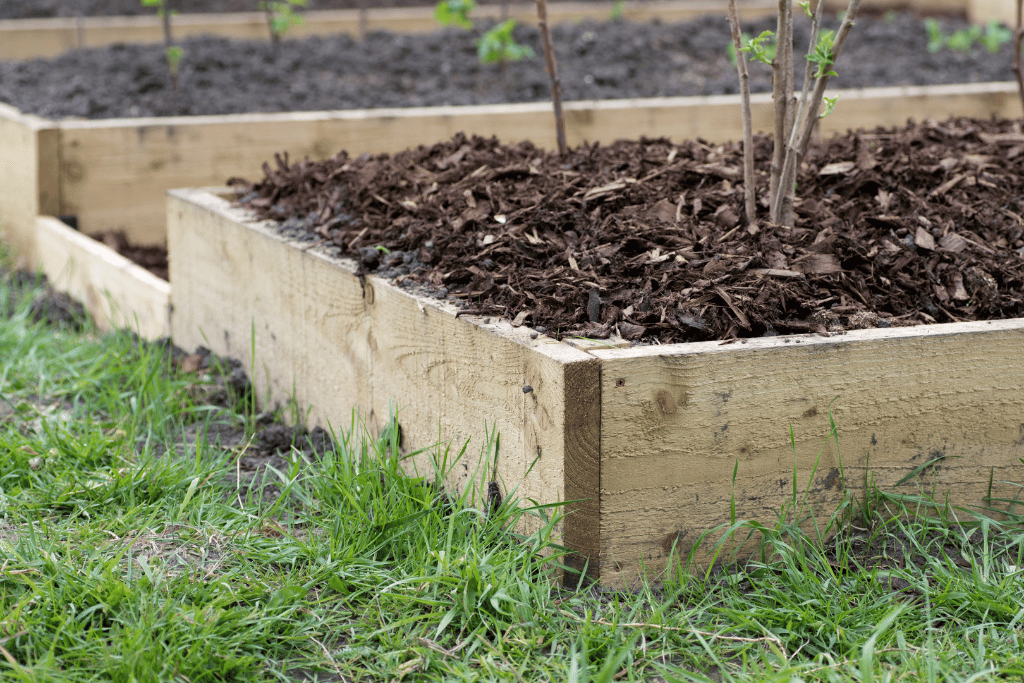
Characteristics: Douglas fir is like that dependable friend who’s always there when you need them. Known for its strength and durability, it’s a relatively cost-effective wood that can stand up to the rigors of outdoor use. Its light color gives it a timeless and classic look, making it suitable for various garden styles.
Pros: Resistant to outdoor conditions, durable, and versatile for different garden styles.
Cons: Requires proper treatment and maintenance.
Best Uses: Ideal for gardeners looking for a wood that can withstand the test of time without breaking the bank.
7. Oak
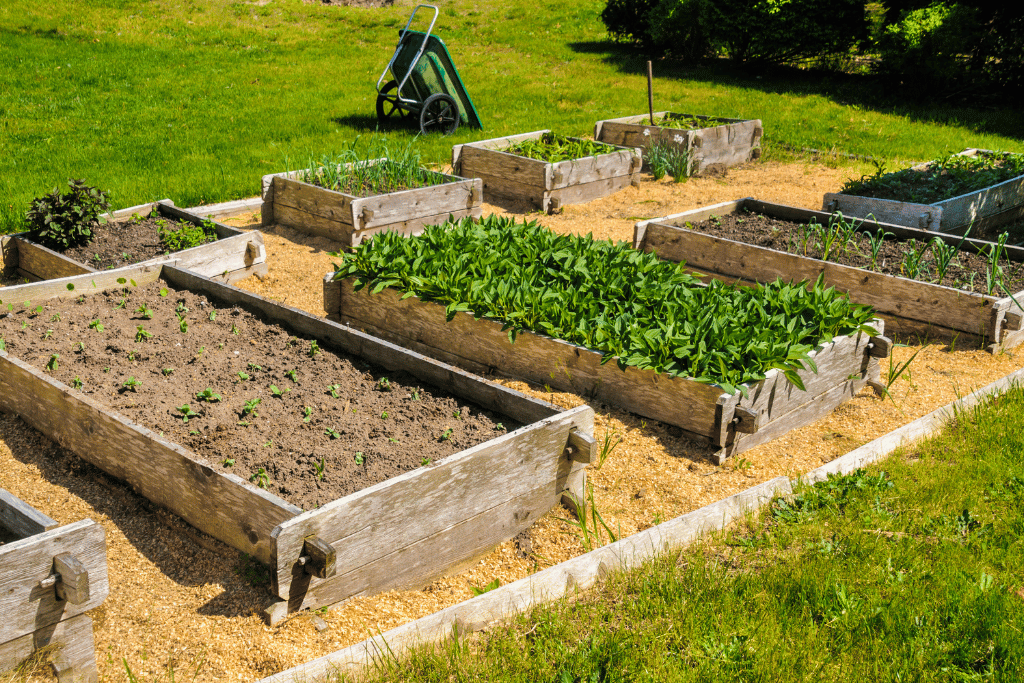
Characteristics: Incredibly strong and durable, oak is like the heavyweight champion of the wood world. It’s dense, robust, and ready to take on whatever Mother Nature throws its way. However, it does come with a relatively higher initial cost.
Pros: Exceptional longevity, sturdy and reliable, and suitable for large garden projects.
Cons: Higher maintenance requirements and can be expensive.
Best Uses: For those seeking the utmost durability, especially for large-scale garden projects.
Each type of wood has its unique characteristics, advantages, and disadvantages, and choosing the best one depends on your specific gardening needs and priorities.
In the next section, we’ll conduct a comprehensive comparison, considering critical factors like rot resistance, durability, cost-effectiveness, sustainability, and maintenance requirements. This will help you make an informed decision and select the ideal wood for raised garden beds.
Comparison of Different Woods
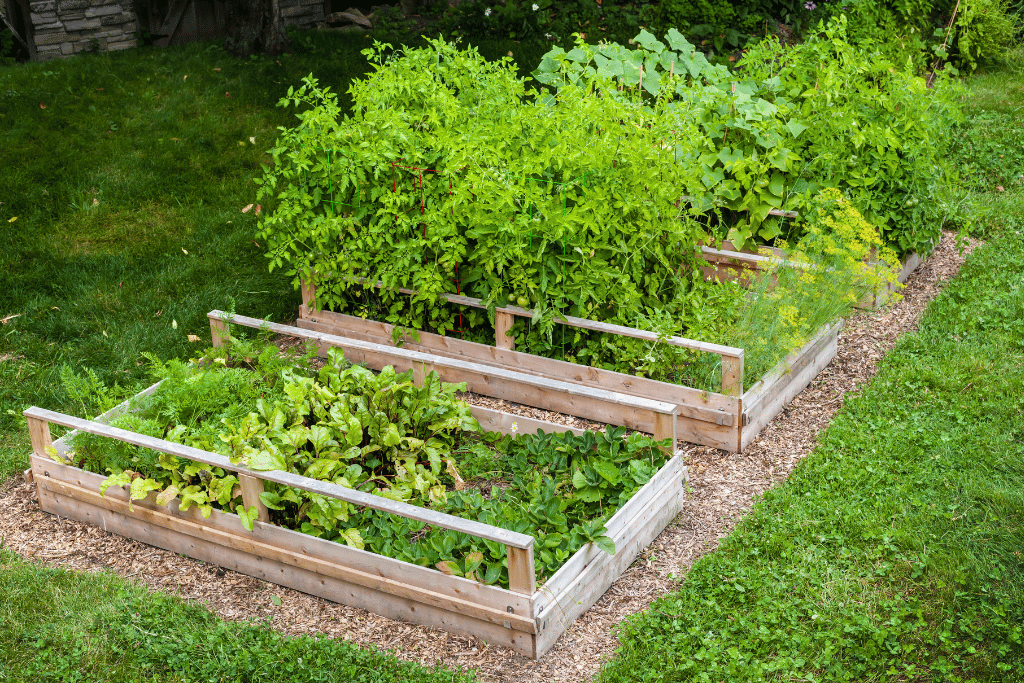
Now, it’s time for the showdown – a battle royale of sorts, but instead of fists and fury, we’ll pit these wood contenders against each other in terms of rot resistance, durability, cost-effectiveness, sustainability, and maintenance requirements. Let’s see how they stack up against one another:
Rot Resistance
When it comes to garden beds, you want wood that won’t crumble and decay over time. Rot resistance is a crucial factor to consider. Here’s how our wood options measure up:
- Cedar: Cedar shines in this department. It’s naturally rot-resistant, which means it can stand up to moisture and damp soil without succumbing to decay.
- Redwood: Like cedar, redwood is naturally resistant to rot, ensuring your garden bed’s longevity.
- Pressure-Treated Wood: This wood gets a boost in rot resistance through chemical treatments, making it a decent choice if you’re on a budget.
- Composite Wood: Composite wood doesn’t rot, thanks to its plastic component, giving you peace of mind for years to come.
- Pine: Pine, while not naturally resistant, can be treated to improve rot resistance, making it a suitable option for those willing to invest some extra effort.
- Douglas Fir: Douglas fir isn’t naturally rot-resistant, so it might require regular maintenance to prevent decay.
- Oak: Oak is strong, but it’s not impervious to rot. Proper care is essential to keep it in top condition.
Durability
Longevity is key when it comes to raised garden beds. You want a wood that can stand the test of time and endure the elements. Here’s how these woods hold up:
- Cedar: Cedar is not just rot-resistant but also quite durable. It can last for many years, making it a smart investment.
- Redwood: Redwood’s natural resistance to decay and insects contributes to its remarkable durability. It’s a wood that can serve you well for a long time.
- Pressure-Treated Wood: While it’s not as naturally durable as cedar or redwood, proper maintenance can extend its lifespan.
- Composite Wood: Composite wood is built for durability. It can withstand the elements and maintain its structural integrity over time.
- Pine: Pine can be durable if treated and maintained correctly, but it might not match the longevity of cedar or redwood.
- Douglas Fir: Douglas fir is durable but may require more attention to keep it in top shape over the years.
- Oak: Oak is incredibly sturdy, but its durability hinges on how well it’s maintained. With proper care, it can last for a long time.
Cost-Effectiveness
Your budget plays a significant role in your wood choice. Some woods might have a higher upfront cost, but it’s essential to consider long-term expenses too:
- Cedar: Cedar, while an excellent choice, can be more expensive initially. However, its low maintenance and durability can balance out the overall cost.
- Redwood: Redwood is on the pricier side when it comes to initial expenses, but its long lifespan and low maintenance costs can justify the investment.
- Pressure-Treated Wood: This wood is often the budget-friendly option. While initial costs are lower, you might need to spend more on maintenance in the long run.
- Composite Wood: Composite wood’s initial cost can be higher than some natural wood options, but its minimal maintenance requirements can make it cost-effective in the long term.
- Pine: Pine is a budget-friendly choice, but its longevity depends on treatments and maintenance, potentially adding to the long-term costs.
- Douglas Fir: Douglas fir provides a balance between cost and durability. It’s more affordable than cedar or redwood, but maintenance expenses should be considered.
- Oak: Oak is on the expensive side initially, and its maintenance requirements might add to the overall cost. However, its durability can make it a worthwhile investment for certain projects.
Sustainability
Gardeners with a green thumb are often concerned about the environmental impact of their choices. Sourcing and sustainability are essential factors to evaluate:
- Cedar: Cedar is a renewable resource, and sustainable harvesting practices make it an environmentally friendly choice.
- Redwood: Similar to cedar, redwood is sustainably harvested, which means you can enjoy its benefits without guilt.
- Pressure-Treated Wood: The environmental impact of pressure-treated wood can be a concern, as it involves chemical treatments. It’s essential to ensure that the treatment process aligns with eco-friendly practices.
- Composite Wood: The sustainability of composite wood depends on the source of its components. Some composite materials use recycled plastic, making them a greener choice.
- Pine: Pine is typically harvested sustainably, but it’s essential to verify the source and any additional treatments applied.
- Douglas Fir: Sustainable harvesting practices can make Douglas fir an eco-friendly choice, but be sure to check the source.
- Oak: Oak can be harvested sustainably, but its slow growth might raise concerns about the depletion of this resource.
Maintenance Requirements
Maintenance is often the less glamorous but equally vital part of the gardening equation. Here’s how these woods stack up in terms of upkeep:
- Cedar: Cedar is low-maintenance. Its natural rot resistance and durability mean you won’t have to fuss over it constantly.
- Redwood: Just like cedar, redwood is easy to maintain. Its natural resistance to decay and insects keeps maintenance tasks to a minimum.
- Pressure-Treated Wood: Pressure-treated wood may need a bit more maintenance, including occasional resealing or restaining to keep it in top shape.
- Composite Wood: Composite wood is a breeze to maintain. No worries about splinters or warping; it stays sturdy with minimal effort.
- Pine: Pine requires regular maintenance, including treatments to enhance rot resistance and sealing to protect against the elements.
- Douglas Fir: Proper care is essential to maintain the longevity of Douglas fir. Regular sealing and attention to potential issues are key.
- Oak: Oak may need more maintenance than other woods due to its density. Proper care, including sealing, is essential to prevent issues.
So – Which Wood Wins?
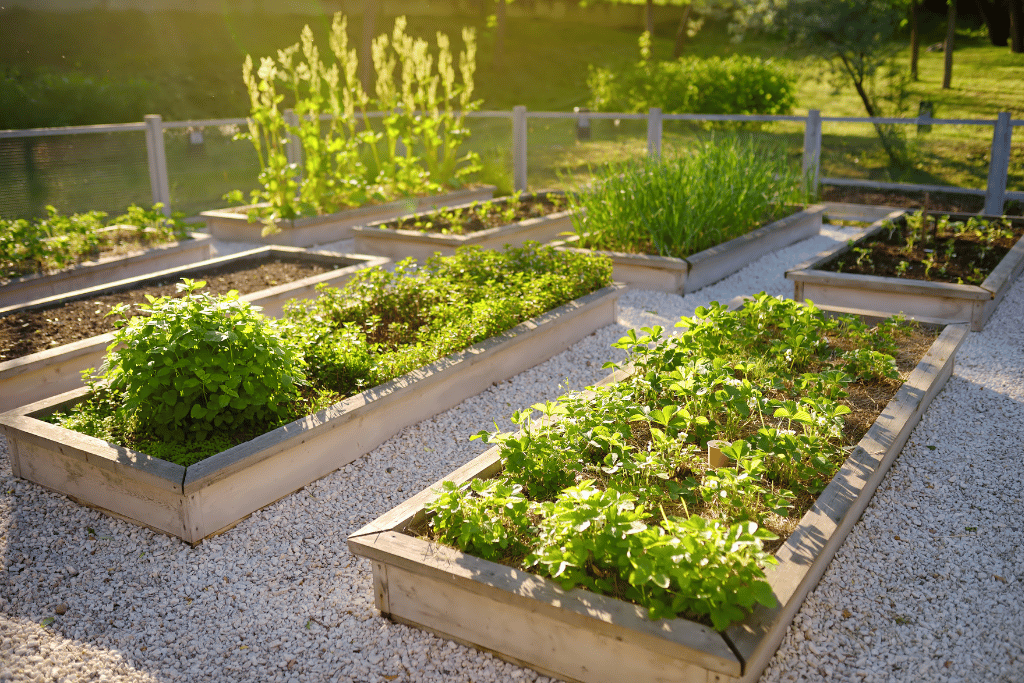
In the battle of the best wood for raised garden beds, it’s not about finding a single “winner” that reigns supreme for every situation. The best wood depends on your specific needs and priorities.
If you’re looking for a wood that’s naturally rot-resistant, easy to work with, and low-maintenance, cedar is a strong contender. Its pleasant scent and aesthetic appeal make it an excellent choice, especially for flower beds.
Redwood is another top-notch option for those seeking a visually stunning and long-lasting garden bed. Its natural resistance to decay and insects, combined with its fine grain and rich color, creates a winning combination.
For budget-conscious gardeners, pressure-treated wood can be a practical choice, especially for vegetable and herb gardens. While it may not match the natural beauty of cedar or redwood, it can offer durability with the right maintenance.
If you want the best of both worlds – durability and a wood-like appearance with minimal maintenance – composite wood is a strong contender.
Pine is a budget-friendly option that can serve well if you’re willing to put in a little extra effort in terms of maintenance.
Douglas fir strikes a balance between cost and durability, making it a versatile choice for different garden styles.
For those seeking ultimate durability, especially for large-scale garden projects, oak is a formidable option.
So, there’s no single “winner” here; the best wood for your raised garden bed depends on your unique circumstances. Consider your budget, the level of maintenance you’re comfortable with, and your specific gardening needs to make the right choice.
FAQS – Best Wood For Raised Garden Beds
What is the safest material for raised garden beds?
Cedar, oak, and redwood are often considered safe materials for raised garden beds. These woods are naturally resistant to decay and insects, reducing the need for chemical treatments. Cedar, in particular, is a popular choice due to its natural durability and resistance to rot.
What is the longest lasting wood for raised garden beds?
Cedar is typically the longest lasting wood for raised garden beds. It contains natural oils and compounds that help it resist decay and insect damage. Cedar can last for many years, often more than a decade, without the need for chemical treatments or preservatives.
How thick should wood be for raised garden beds?
A common recommendation is to use wood that is at least 2 inches thick for raised garden beds. Thicker boards provide greater durability and strength, which is especially important for retaining the shape and structure of the bed over time. Thinner boards may warp or bow more easily, reducing the lifespan of the garden bed.
Can I use untreated pine for raised garden beds?
While untreated pine is an affordable option, it is not as durable as cedar, oak, or redwood and may not last as long. You can still use it, but be prepared for more frequent maintenance and replacement.



